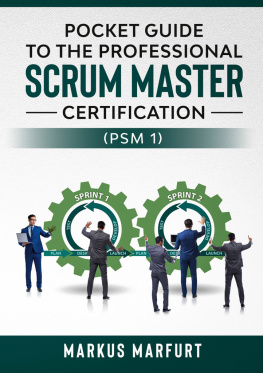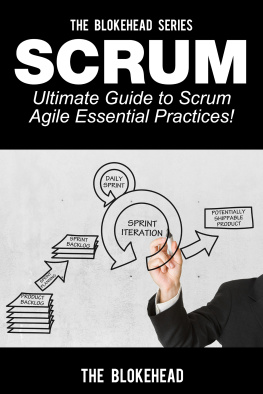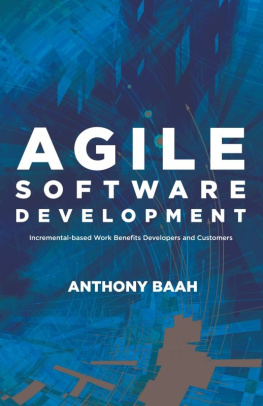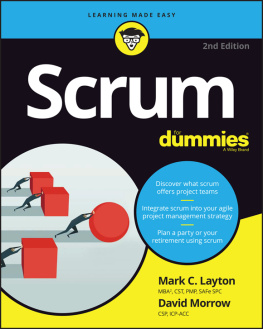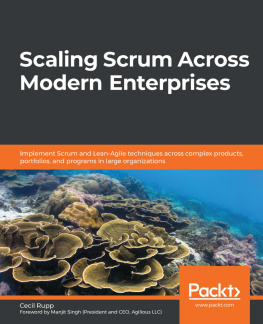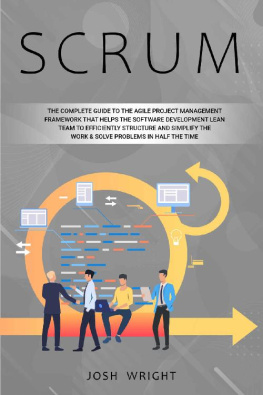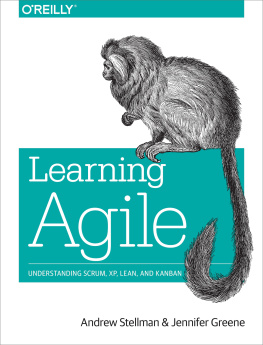The Epic Guide to Agile
More Business Value on a
Predictable Schedule with Scrum
Dave Todaro
Published by:
R9 Publishing LLC
PO Box 232
North Hampton, NH 03862
Copyright 2019 David M. Todaro
All rights reserved. No part of this book may be reproduced or transmitted in any form or by any means, electronic or mechanical, including photocopying, recording or by any information storage and retrieval system without written permission of the publisher, except for the inclusion of brief quotations in a review.
Copy Editor: Noleen Arendse
Content Editor: Wayne Arendse
Proofreaders: Steven Codd, Diana Getman, Allison Grappone, Susannah Parnin Mitchell, Tom Schwendler
Marketing: Sara Janjigian Trifiro
Interior Design: Dave Todaro
Cover Design: Global Deziners
This book expresses the authors views and opinions. The information in this book is provided without any express, statutory, or implied warranties. Neither the author, R9 Publishing LLC, nor its resellers, or distributors, will be held liable for any damages caused or alleged to be caused either directly or indirectly by this book.
Product and company names mentioned herein may be the trademarks of their respective owners. Rather than use a trademark symbol with every occurrence of a trademarked name, we are using the names only in an editorial fashion and to the benefit of the trademark owner, with no intention of infringement of the trademark.
The example companies, organizations, products, domain names, e-mail addresses, logos, people, places, and events depicted herein are fictious unless otherwise noted. No association with any real company, organization, product, domain name, e-mail address, logo, person, place, or event is intended or should be inferred.
Paperback ISBN: 978-1-7330004-0-6
Digital ISBN: 978-1-7330004-1-3
Contents at a Glance
Table of Contents
Preface
An expert is a person who has found out by his own painful experience all the mistakes that one can make in a very narrow field.
- Neils Bohr , Danish physicist.
Years ago, I was in charge of developing a new product at my software company. After about 10 months of discussions, research, and focus groups, we had identified a new business problem to solve for our customers, and we decided to spin up a development team to get it built.
About a year and a half later, we were nearing the release of version 1.0. The only problem was we were running about six to seven months behind my original schedule estimate, and we had started pulling developers off other projects to drive it to done. Everyone was working crazy hours to get the thing out the door, and we were all ready to be finished.
As we neared the release, I sat down for a meeting with the CEO and the lead sales rep to give them a status update. From my perspective, I felt that although it was later than I originally thought, the project was a huge success. We had worked really hard, with everyone putting everything else second for monthsincluding their families. I came into the meeting with a smile on my face.
That didnt last long.
As I sat down, I looked over to the CEOwho was also my business partnerand he said, Youve failed.
It didnt really sink in at first. Feeling my face start to get hot I said, What the hell do you mean? We busted our asses to get this thing done and its about a week away from shipping. Customers are psyched to get their hands on it.
Yeah, but youre seven months late! We were planning on having money from that product in the bank. Youve put us in a tough spot.
After more than a year and a half of putting all I had into this new productat the expense of everything else in my lifeI was exhausted. In hindsight, I was probably on the edge of a nervous breakdown. The meeting quickly went downhill from there, evolving into a yelling match with plenty of finger-pointing, and ending with me storming out of the conference room and leaving the office for the day.
It was one of the worst days of my life.
Product Development Is About Business Value
My team and I had finished the product , which is a feat given that over half of IT projects fail (Florentine, 2016). Everyone agreed it was a great piece of software.
I had done a road tour to a handful of customers during the previous month and they were all excited to get their hands on what we had created. How could I have possibly failed ?
Once I had time to reflect, I realized two things:
Software developmentunless in an academic or research contextisnt about technology, its about delivering business value. In this case, that business value was in the form of a new product to drive higher revenue from our customers.
Delivering business value doesnt matter if its not on a predictable schedule . Otherwise, its impossible for the business to create plans to maximize that value. When will I get this revenue? is a critical question to answer.
The problem wasnt the productcustomers loved it. It was that I had spent too much time and money getting it done. The company needed to get business value faster than my team and I provided.
Even though I had started to use an agile Scrum framework a year or two before starting this product, I later realized that I didnt really know what I was doing. I was using the right terminology and having the right meetings, but I wasnt properly leveraging Scrum to ship the product on a schedule.
After a lot of soul-searching, I finally admitted to myself that I had, in fact, failed.
Scrum Done Right Delivers Results
My experience with that projectnow close to ten years agowas a pivotal moment in my life. A year or two later, I decided to sell my business interest to my partner and start a new company, which I called Ascendle.
I had one goal: leverage all my hard-won experience to provide world-class, turnkey agile development teams to enterprise clients.
These self-contained teams could be free to innovate at an unprecedented pace, leveraging the best of todays tools and technologies.
Everett Rogers, in his book Diffusion of Innovations , described skunkworks to mean an especially enriched environment that is designed to help a small group of individuals escape usual organizational procedures, so that innovation is encouraged. (Rogers, 1995)
This is exactly what we providean on-demand skunkworksand we deliver results daily at a blistering pace our clients have never experienced.
Why I Wrote This Book
Software development is hard . Ive spent more than three quarters of my life figuring out how to make it easier. And Ive finally arrived at a specific set of tools and techniques to deliver on that promise.
Its still a lot of work to ship a world-class product, but using the information in this book will make your life a hell of a lot more enjoyable.
Over the last 35+ years, Ive made three key discoveries:
Leveraging an adaptable and flexible framework such as Scrum is critical. No two organizations are the same, so prescriptive, one-size-fits-all methodologies dont work.
Being fanatical about disciplined adherence to the ruleswhile constantly innovating within their boundariesis a key success factor.
Attempting to use agile techniques without the appropriate technical underpinnings is a recipe for failure.
I tried to find one book that included a complete how-to guide for both Scrum and the required technical tools and techniques. As I searched through my own library and browsed books on Amazon, I couldnt find one.
Most focus on the fundamental details of Scrum, including forming a team and running the day-to-day process. Other books have a narrow focus on a small portion of the process, such as testing or how to scale Scrum in larger organizations or include only lightweight technical details.
Next page

